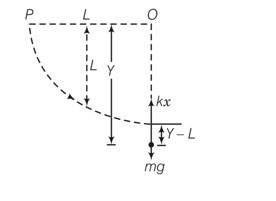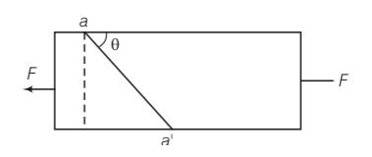Physics NCERT Exemplar Solutions Class 11th Chapter Nine
Get insights from 28 questions on Physics NCERT Exemplar Solutions Class 11th Chapter Nine, answered by students, alumni, and experts. You may also ask and answer any question you like about Physics NCERT Exemplar Solutions Class 11th Chapter Nine
Follow Ask QuestionQuestions
Discussions
Active Users
Followers
New answer posted
4 months agoContributor-Level 10
This is a short answer type question as classified in NCERT Exemplar
stress=
Therefore stress is scalar quantity not vector quantity.
New answer posted
4 months agoContributor-Level 10
This is a short answer type question as classified in NCERT Exemplar
Young's modulus Y= stress/longitudinal strain
For same longitudinal strain,
Ysteel>Yrubber
so we can say that stresssteel > stressrubber
New answer posted
4 months agoContributor-Level 10
This is a long answer type question as classified in NCERT Exemplar
Till the stone drops through a length L it will be in free fall. After that the elasticity of the spring will force it to a SHM. Let the stone come to rest instantaneously at y.
The loss in PE of the stone is the PE stored in the stretched string .
Mgy=1/2 k(y-L)2
Mgy =
=
Y=
b)in SHM the maximum velocity is attained when the body passes through the equilibrium position i.e when instantaneous acceleration is zero. That is mg-kx=0
so mg=kx
from the conservation of energy
mg=kx
x=mg/k
v2=2gL+mg2/K
v= (2gL+mg2/K)1/2
c)when stone is at lowest position i.e at instantaneo
New answer posted
4 months agoContributor-Level 10
This is a long answer type question as classified in NCERT Exemplar
Consider the diagram according, the bending torque on the trunk of radius r of the tree =
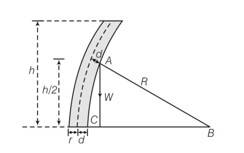
When the tree is about to buckle Wd=
If R>>h, then the centre of gravity is at a height l
From 2+ (h/2)2
If d <2+
So d = h2/8R
If wo is the weight /volume
h= ( )1/3r2/3
critical height = h= ( )1/3r2/3
New answer posted
4 months agoContributor-Level 10
This is a long answer type question as classified in NCERT Exemplar
l1=AB ,l2=AC ,l3=BC
Cos =
2l3l1cos =
Differentiating 2( )cos -2
= 2
= d
=d
=d
( + )cos + = + -
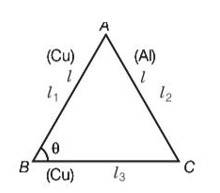
sin (1-cos )-
d
= 2
d = change in the angle ABC
=New answer posted
4 months agoContributor-Level 10
This is a long answer type question as classified in NCERT Exemplar
Consider an element of width dr at r
Let T(r) and T(r+dr) be the tensions at r+dr respectively
So net centrifugal force = w2rdm
= w2r
T(r)-T(r+dr)= w2rdr
-dT= w2rdr
-
T(r)=
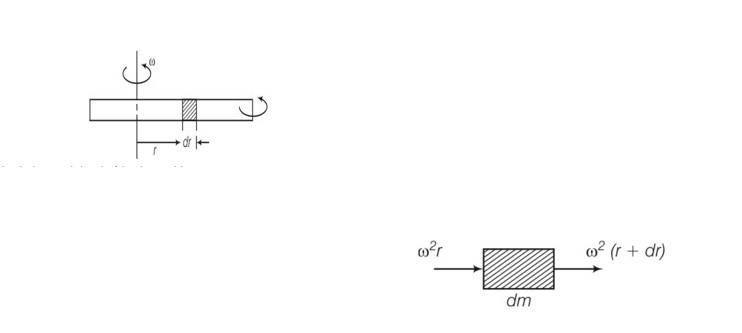
Let the increase in length of the element dr be
So Young's modulus Y= stress/strain=
(l2-r2)
Change in length in right part =
=
Total change in length =
New answer posted
4 months agoContributor-Level 10
This is a long answer type question as classified in NCERT Exemplar
When a small element of length dx is considered at x from the load x=0
(a) letT(x) and T(x+dx) are tensions on the two cross sections a distance dx apart then
T(x+dx)+T(x)=dmg= dxg
dT= gx+C
at x=0 T(0)=mg
C=mg
T(x)= gx+Mg
Let length dx at x increases by dr then
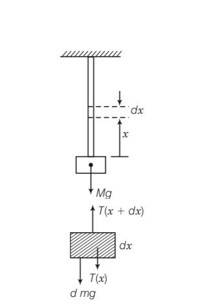
Young's modulus Y= stress/strain
r=
= 0L
r=
so r = 4
(b) tension will be maximum at x=L
T= +Mg=(m+M)g
The force = (yield strength) area=
(m+M)g= 250
Mg
M= 25
New answer posted
4 months agoContributor-Level 10
This is a long answer type question as classified in NCERT Exemplar
Let the cross sectional area A . consider the equilibrium of the plane aa'. A force F must be acting on this plane making an angle of with the normal ON. Resolving F into components along the plane (FP) and normal to the plane.
By resolving into components
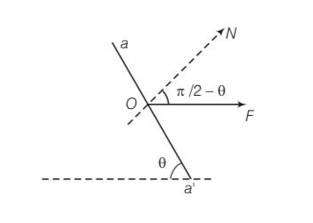
We get Fp= Fcos
And FN= Fsin
Let area of the face aa' be A' then
A/A'=sin so A=A'sin
The tensile stress = normal force/area=Fsin
= sin2
Shearing stress = parallel foce/Area
=
a) For stress to be maximum , sin2 =1
So =
b) Shearing stress to be maximum
sin2
So =
Taking an Exam? Selecting a College?
Get authentic answers from experts, students and alumni that you won't find anywhere else
Sign Up on ShikshaOn Shiksha, get access to
- 65k Colleges
- 1.2k Exams
- 686k Reviews
- 1800k Answers

